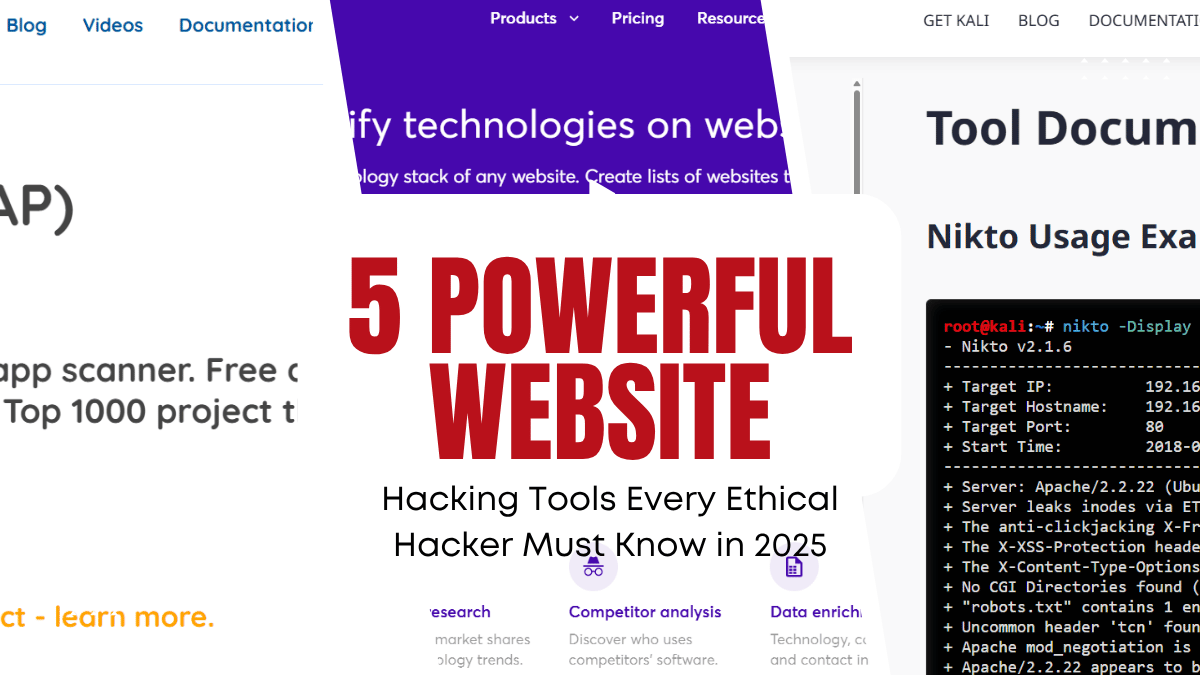5 Powerful Website Hacking Tools Every Ethical Hacker Must Know in 2025
5 Powerful Website Hacking Tools:
Introduction:
Website hacking is no longer limited to a few dark corners of the internet. In 2025, ethical hackers, penetration testers, and bug bounty hunters use a variety of tools to discover vulnerabilities before malicious hackers do. Understanding these tools is essential for learning website security.
In this article, we’ll cover 5 powerful tools used for website hacking, with simple explanations for beginners. Whether you’re pursuing CEH, CPENT, or a bug bounty path—these tools are essential in your hacking journey.
1. Burp Suite – The Web Application Testing King

What is it?
Burp Suite is a powerful proxy-based tool used for analyzing and attacking web applications. It’s a favorite for security professionals because it can intercept traffic between the browser and server.
Key Features:
- Intercept and modify HTTP requests/responses
- Scan for vulnerabilities like XSS, SQLi, CSRF
- Built-in repeater, intruder, and sequencer tools
- Plugin support with BApp Store
Use Case:
Ethical hackers use Burp Suite to test forms, cookies, APIs, and authentication mechanisms to find hidden flaws.
🔍 Why It’s Powerful:
It gives complete control over web traffic and allows manual and automated testing of web app vulnerabilities.
2. Nikto – The Web Server Scanner

What is it?
Nikto is an open-source command-line scanner that checks for dangerous files, outdated server software, and misconfigurations.
Key Features:
- Detects 6700+ potentially dangerous files
- Finds default files and scripts
- Checks outdated versions of over 125 servers
- Fast scanning with detailed output
Use Case:
It’s used during initial reconnaissance to scan large web targets quickly and get a summary of low-hanging fruits.
🔍 Why It’s Powerful:
Nikto is fast, lightweight, and perfect for quick vulnerability assessments.
3. SQLMap – Automated SQL Injection Tool

What is it?
SQLMap automates the process of detecting and exploiting SQL injection vulnerabilities in database-driven websites.
Key Features:
- Supports multiple databases (MySQL, MSSQL, Oracle, etc.)
- Can perform database fingerprinting
- Extracts data from vulnerable parameters
- Can even get DB usernames, passwords, and more!
Use Case:
Penetration testers use SQLMap to check if any form field or URL parameter can be used to access or manipulate the database.
🔍 Why It’s Powerful:
It saves hours of manual injection efforts and uncovers critical database-level flaws in minutes.
4. OWASP ZAP (Zed Attack Proxy) – Open-Source Alternative to Burp

What is it?
ZAP is a web application security scanner from the OWASP Foundation. It’s beginner-friendly and great for automated scanning.
Key Features:
- Active and passive scanning
- Spidering and fuzzing
- Easy integration with CI/CD tools
- GUI-based interface for ease of use
Use Case:
Perfect for developers and testers who want to integrate vulnerability checks in their development pipeline.
🔍 Why It’s Powerful:
ZAP is free, open-source, and supports automation—making it ideal for secure DevOps practices.
5. Wappalyzer – Technology Profiler for Reconnaissance

What is it?
Wappalyzer is a browser extension and CLI tool that identifies technologies used on websites like CMS, eCommerce platforms, frameworks, and analytics.
Key Features:
- Detects CMS (like WordPress, Joomla)
- Identifies JS frameworks (React, Angular)
- Shows server software, CDN, and tracking tools
- Useful during recon for attack surface mapping
Use Case:
Used in the recon stage of hacking to understand the tech stack before launching specific attacks.
🔍 Why It’s Powerful:
It gives you the attacker’s view of a website’s infrastructure in seconds.
Final Thoughts
All these tools are legal and ethical—only when used with permission. At Axximum Infosolutions, we teach aspiring cybersecurity professionals to use these tools responsibly during ethical hacking, penetration testing, and bug bounty programs.
Whether you’re a beginner or already in the field, mastering these tools will give you an edge in identifying and fixing real-world vulnerabilities.
⚠️ Disclaimer (5 Powerful Website Hacking Tools)
This article is for educational purposes only. Do not use these tools on websites or systems you don’t own or have permission to test. Unauthorized access is illegal and punishable under cybersecurity laws.







